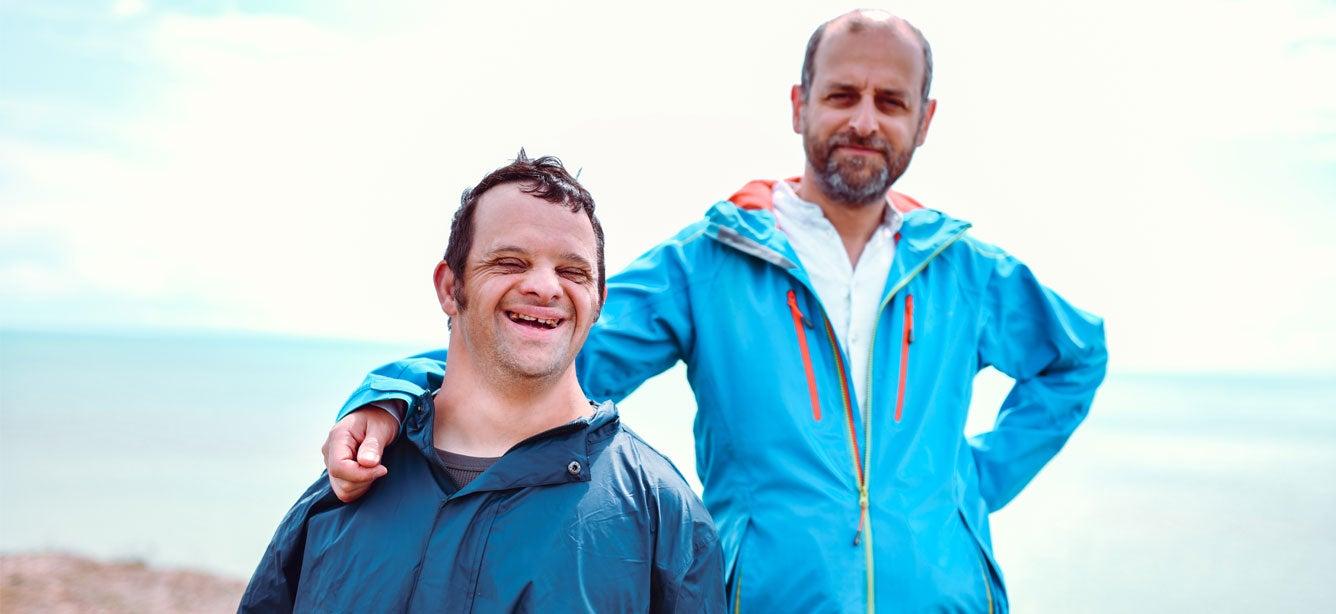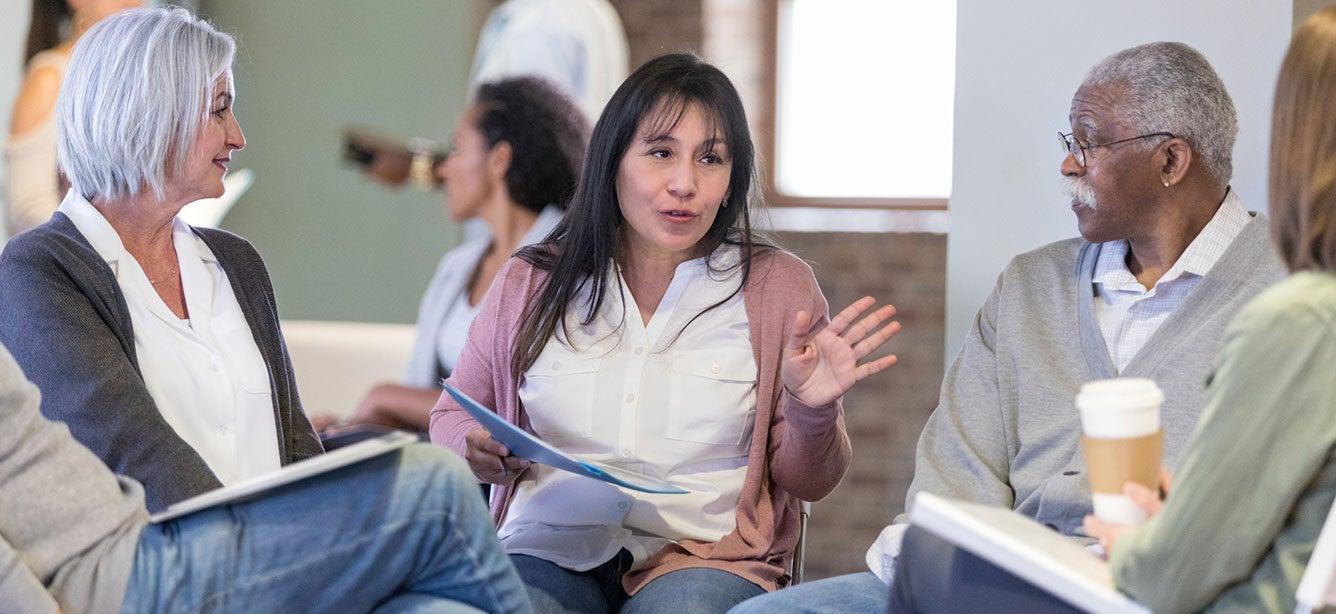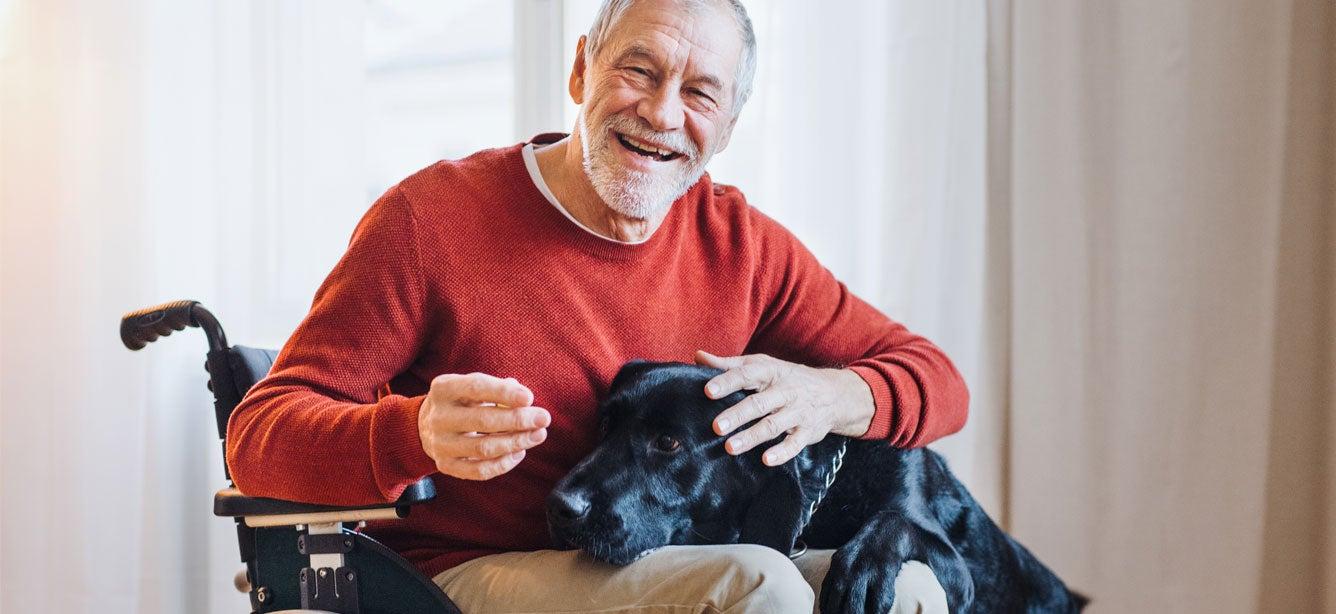Tip Sheet: Engaging People with Disabilities in Evidence-Based Programs
5 min read

Directors, program coordinators, trainers, group facilitators, partners, and others involved in program efforts must feel comfortable and be competent in interacting with people with disabilities. Further, to ensure ongoing participation, people with disabilities must feel welcome and respected in environments in which programs are offered. Find helpful information and tips on disability literacy and etiquette, as well as accessibility and accommodations.
Rates of disability increase with age. According to the American Community Survey (ACS), people with significant disabilities account for more than 12% of the population in the United States.1 However, among people aged 65 and older, nearly 37% have a disability.2
People with disabilities are a varied group. Some people are born with a disability and others acquire a disability as a result of injury or illness/chronic condition. A person may be aging with a disability or acquire a disability as they age. An individual may have a physical, developmental, cognitive, sensory, or emotional disability, which can impact the ability to integrate into their community and fully participate in community programs and activities.
Integrating people with disabilities into overall community-based programs includes advocating for full accessibility. All activities should be welcoming to people with disabilities, regardless of the type of disability or the accommodation that might be required.
Health differences
Research has shown that adults with disabilities are four times more likely to report their health to be fair or poor than people without a disability. As a group, people with disabilities experience worse health than the general population.3
According to the Interagency Committee on Disability Research (2010), people with a variety of physical and cognitive disabilities were more likely to experience poorer health status, potentially preventable secondary conditions, chronic conditions, and early deaths.
Data have shown that people with disabilities have higher rates of obesity, lack adequate physical activity, and have increased smoking patterns.4 Furthermore, rates of cardiovascular disease are higher, as are rates of diabetes and depression. Women with physical disabilities often have lower rates of access to preventative services, such as screenings for mammograms and Pap tests, that may result in a later stage diagnosis if cancer is detected.5 Three out of five people with serious mental illness die 25 years earlier than other individuals from preventable, co-occurring chronic diseases such as asthma, diabetes, cancer, heart disease, and cardiopulmonary conditions.6
Current research indicates that adults with disabilities are 2.5 times more likely to report skipping or delaying health care visits because of cost.7 Even though adults with disabilities have higher rates of chronic diseases than the general population, they are less likely to receive preventive care. Inaccessible offices and medical equipment, as well as the lack of trained physicians, dentists, and other health professionals prevent individuals with disabilities from receiving basic primary and preventive care.8
It is imperative to include people with disabilities in programs to prevent and manage chronic diseases and conditions. One of the recommended ways to address the health inequities that exist for people with disabilities is integration into community-based programs.
However, in order to effectively and successfully integrate, it is essential to be mindful of disability culture, which includes understanding of disability literacy, disability etiquette, and inclusion/accessibility challenges.
Disability literacy
Disability literacy is a combination of elements, including an awareness of disability etiquette, recognizing cultural differences, providing full accessibility, and making materials available in alternative and accessible formats.9 For example, when hosting a meeting, disability literacy would imply that the entity hosting the meeting would have sufficient internal capacity to host a meeting in a fully accessible building, provide materials in alternative formats, be mindful of transportation access, and provide other accommodations requested by meeting participants.
If an environment is accessible, a person with a disability can likely maneuver in the setting. If a person needs help, he/she will communicate their need to you. People with disabilities want and should be treated as independent people.
Disability etiquette and "people first" language
As described in National Disability Navigator Resource Collaborative (NDNRC) “Guide to Disability Healthcare Insurance Marketplace Navigators,” basic disability etiquette involves treating people with disabilities with respect. For example, speak to the person directly, not to the person accompanying them. For those who use wheelchairs, it is best to speak to them from a sitting or kneeling position, so that the person with a disability does not have to strain their neck looking up during a conversation, especially during lengthy conversations.
Do not make assumptions about what a person with a disability can or cannot do. The impact of a specific disability can vary widely from person to person, so offer assistance only if it appears to be needed. Acknowledge and respect the individual’s ability to make decisions and judgments on their own behalf.10
It is important to use “people first” language. For example, use the term “people with disabilities.” Do not use terms such as “the disabled” or “the handicapped.” Avoid referring to people by their disability. For example, do not say, “She is an epileptic.” Instead, say, “She has epilepsy.” Do not say “wheelchair-bound” or “confined to a wheelchair.” Most wheelchair users perceive their wheelchair as liberating, not confining. It is proper to say, “She uses a wheelchair” or “She is wheelchair mobile.” Never use negative, demeaning, or outdated terms such as “cripple,” “deaf and dumb,” or “retarded.”11
Avoid using terms such as “physically challenged,” or “differently abled.” Also, avoid referring to an individual with a disability as someone who is “suffering from cerebral palsy or multiple sclerosis.” Please see the guidance prepared by the Research and Independent Living Center at University of Kansas entitled, “Words to Use” at the end of this document.
While “people first” language is most often used, some individuals may prefer “identity-first” language. For example, “autistic person,” “disabled individual,” or “Deaf” may be used to portray a sense of culture and pride. When in doubt, ask.
Tips for interacting with people with all types of disabilities
The information below is provided as a resource to convey guidance and increase one’s confidence with being sensitive and culturally appropriate when interacting with people with different types of disabilities. The first nine bullets are more broad based and useful to remember when interacting with people with different types of disabilities. The next seven categories are provided as a guide when interacting with people with specific types of disabilities.
- Use people first language/put the person first (unless individuals prefer other language).
- Introduce yourself and offer a handshake. People with limited hand use or who wear an artificial limb can usually shake hands. The person will often tell you if they are not able to shake hands.
- Always ask before providing assistance—wait until the offer is accepted. Do not touch a person on their head or touch their wheelchair, scooter, cane, or any assistive device.
- Speak directly to the person and not their attendant, interpreter, family member, etc.
- Do not pet service animals without checking with the owner first.
- It is acceptable to ask questions if you are unsure how to proceed or what to do next.
- At the beginning of any meeting, workshop, or seminar, always identify where the accessible restrooms are located.
- Remember: A disability does not define a person—it is part of a person.
- Some disabilities are hidden and not at all apparent or obvious. Please respect every person’s requests and needs.
People with mobility disabilities
- Do not push or touch a person’s wheelchair/scooter without their permission—a wheelchair is part of the personal body space of the person.
- Try to ensure there is space in your waiting room, office, or group meeting space for someone in a wheelchair or scooter to comfortably wait in his or her chair.
- If you are speaking with a person who uses a wheelchair or a person who uses a mobility device for more than a few minutes, place yourself at eye level in front of the person to facilitate the conversation.
- If giving directions to a person in a wheelchair, be sensitive to distance, as well as physical obstacles such as stairs, hills, curbs, and doors.
- Individuals who use a cane or crutches need their arms to balance themselves, so do not grab them. Be careful about pushing a door open too quickly, as this may cause a person to lose their balance and fall.
- Be mindful of wet floors or conditions of floors on snowy, wet, or rainy days, as falls are a big problem for people who use mobility devices or have limited mobility.
People who are blind or have low vision
- Always introduce yourself and anyone else who is present for the conversation. For example, “On my right is John Jones.”
- If you are leaving the room, tell the person you are leaving. If there is an interruption, such as a phone ringing, a knock on the door, or someone joining the group, explain the interruption.
- When conversing in a group, identify the person who is speaking and to whom you are speaking.
- Speak directly to a person who is blind or low vision, not through a companion.
- Offer to read information to a person when appropriate.
- If you are asked to offer guidance, offer your arm so the person can grasp your elbow and proceed at a normal pace. Do not take a person’s arm and move them by the elbow.
- Never leave a blind person standing alone in the middle of a room. Escort the person to a seat or place their hand on “a point of reference,” such as a wall or table. If a person is using a cane and sets it down, do not move the cane—the cane is part of the individual’s personal space.
- Walk on the side opposite the guide dog. Do not pet a guide dog—the dog is responsible for guiding his/her master who cannot see and should not be distracted.
- If assisting a person to a chair in your office, place his or her hand on the back of the chair; do not try to push the person into a chair. Offer specific directions such as “turn left at 50 feet.”
- A person of low vision may request large print materials. Usually bold, white letters on a black background are easiest to read. Be sure the lighting in the room is good, but not so bright as to present a glare.
People who are deaf, hard of hearing, or have a hearing loss
- Let the person establish the preferred method of communication for your conversation, such as lip reading, sign language, or note writing. It is helpful to have this information before a meeting or activity.
- Make sure you get the person’s attention before you begin to communicate. It is not considered rude to lightly touch people you do not know to get their attention.
- If using a sign language interpreter, speak directly and clearly to the person who is deaf in your normal voice and make eye contact with that person, not to their sign language interpreter.
- Feel free to use gestures and visual cues, such as holding up items that you are discussing.
- Explain if there is an interruption such as a phone ringing, knock at the door, a person entering the room or group or any activity that is disruptive.
- Be sure to have an American Sign Language (ASL) interpreter in the group if the person has made a request.
- For large groups, provide microphones for the speakers.
People with speech or language disorders
- People with speech and language disorders may take longer to communicate with you—be patient and respectful.
- Be sensitive and do not interrupt or finish the person’s sentence. You can repeat for verification if you are not sure you understood what the person is saying. You may also ask the person to facilitate communication in another way, perhaps, ask the person to write down what he/she is attempting to say.
- Ask one question at a time, giving the person time to respond before moving on.
- If the person uses any assistive technology devices, make sure the devices are always within the person’s reach.
- Some people may have slurred speech and involuntary body movements due to certain conditions, such as cerebral palsy or neurological challenges—be patient and take time to ascertain what the person is saying.
People with cognitive, developmental, or intellectual disabilities
- Keep communication simple, using short sentences and completing one topic before moving to the next. Break down communications into smaller pieces.
- If possible, use pictures, pictograms, or other visual aids.
- If possible, provide information ahead of meetings in simple language and ask if the individual needs a support person to assist with reviewing and understanding materials.
- Ask if the person has any questions or if there is anything that needs to be clarified. If you feel it is necessary, repeat what you understand the person to be saying and ask for confirmation if your understanding is correct.
- Sometimes people with auditory processing challenges may need the information given to them in writing.
- Do not talk down to people who have developmental disabilities—use some of the communication tips above to monitor your delivery and keep the communications easy to understand. If a person seems anxious or agitated, speak calmly and offer to repeat information.
- If a person seems nervous or confused, be willing to break things down step-by-step.
- Respect a person’s choice of language or terminology. For example, if they ask you to refer to something as a “mental health condition” instead of a “mental illness,” listen to their request. If they say they don’t have a mental health condition, but identify mental health treatment as a medical need, don’t disagree.
- If a person becomes upset or anxious, he or she may be confused or overwhelmed. Speak in a normal, calm tone of voice, repeat necessary information, and reassure them.
- If a person brings a relative or friend to a meeting, be sure to speak directly to the person.
People using service animals
- Service animals are generally well-behaved and have received intense training.
- Do not touch the service animal without permission.
- Remember, the service animal is working. People who are deaf, blind, have low vision, traumatic brain injury, seizure disorders, or other types of disabilities may use service animals to assist with daily living.
Disability accessibility and accommodations
When planning a meeting or group event, it is important to consider not only the physical accessibility of the meeting site, but also other factors. For example, transportation is a key component to be considered when integrating people with disabilities and chronic health conditions into community activities. Prior to a meeting or group activity, it is also important to ask the participants if they require any special needs or accommodations to participate. When hosting group meetings or activities, it is much better to be clear from the onset about your participants’ needs in order to fully participate and be included.
The requirements may vary from providing a sign language interpreter, to offering the materials in alternative formats, to having tables that are at a height to accommodate wheelchairs. The following are basic tips on venue accessibility that should be considered to ensure that a meeting site is accessible for participants, whether the individual has a physical, cognitive, sensory, or emotional disability.
Parking lot accessibility
- Are accessible parking spaces clearly marked with an “Accessible” sign?
- Are accessible parking spaces closest to the building?
- Are accessible parking spaces flat?
- Does accessible parking space have an adjacent striped access aisle next to the accessible parking spot?
Building accessibility
- Is the accessible entrance clearly marked?
- Is there an automatic door opener at the accessible entrance?
- Is the route between accessible parking and accessible building entrance free of any obstacles?
- Is there a curb cut from accessible parking lot to the accessible entrance?
- If there are steps to the building entrance, are there handrails for people using canes or walkers?
- Is there a threshold at the bottom of the entrance that is rounded so a person who has a visual challenge or a person using an assistive device or wheelchair will be able to maneuver?
Elevator accessibility
- Do the elevator doors stay open a minimum of five seconds?
- Are the elevator doors a minimum of 36” wide?
- Is there a sign near the elevator with raised Braille characters that includes floor numbers?
- Do the buttons inside of the elevator have raised Braille characters?
Ramp accessibility
- Ramps must be provided if there are steps to the entrance.
- Ramps must have flat landings.
- Ramps must have a minimum steepness—one inch of “rise” (height) to every foot of “run” (length).
- If there is more than one inch of rise (height) for every 12 inches of run (length), the ramp is too steep.
- Are there handrails on the ramp?
Meeting room accessibility
- Are there open spaces so people who use wheelchairs, scooters, strollers, canes, and service animals can easily be accommodated? This does not mean space at the back of the room or just on the side.
- Are signs posted in the meeting room that explain where restrooms are?
- Are the doors wide (36”) enough so that a person in a wheelchair and scooter can easily enter?
Restroom accessibility
- Is the doorway at least 36” wide?
- Is there an accessible stall in the restroom? Is there adequate room for a wheelchair to enter the stall and turn around within the stall?
- Is the width of the accessible stall at least 60” so that someone can transfer from a wheelchair or scooter to the stall?
- Is there a horizontal grab bar on the side of the toilet? Is there a vertical grab bar that a person sitting on the toilet can grab onto?
- Is the top of the toilet seat between 17-19” from the surface of the floor?
- Can the water in the sink be turned on and off with one hand or a closed fist? Is there “knee space” below the sink so a wheelchair can fit under and the person can wash their hands?
Alternative formats
- It is important to ask your participants if they need to have materials available in alternative formats. This could mean electronic (e-text, scanned text, web-based text), large print versions of printed materials, thumb drives, audio (for low vision or blind to have ability to “read” or access information through hearing), and Braille.
- Sign language interpreter—sign language interpreters are highly skilled and trained to facilitate communication between hearing individuals and people who are deaf or hard-of-hearing. If an individual requests a sign language interpreter, you should comply with their request.
Packaging and messaging of materials
-
If you want to include people with disabilities or chronic health conditions in your activities, be sure to include them in your promotional materials. For example, if you create a flyer for a meeting, include a person with a disability on the brochure. If you are reaching out to a specific population, include an appropriate picture on your materials. If you are creating a PowerPoint presentation, use a color scheme that presents a sharp contrast between text and background. If you use any video, be sure to caption the embedded video.
Font size
- Remember to use a font size of at least 12. Recommended fonts for materials are Arial, Times New Roman, Verdana, and Helvetica.
- For people with low vision, remember to keep the font clear with appropriate spacing. Do not use all uppercase letters, as it is hard to determine when a sentence begins and ends. Black background with white letters works best.
Guidelines for communications: Words are powerful—They have the ability to inspire and also hurt
The following guidelines were adapted and used with permission from the Research and Training Center on Independent Living at the University of Kansas. These guidelines describe preferred terminology, but they are not a substitute for one-on-one conversations with individuals to inquire about language they deem most appropriate to their life experiences.
DO SAY
Disability
People with disabilities
Person with a learning disability
Person with quadriplegia
Person with Down Syndrome
Person of short stature
Burn survivor
Accessible parking
Brain injury
Post-polio syndrome
Uses a wheelchair, or wheelchair user
Cleft lip
Seizure
Speech disorder
Congenital disability
Intellectual or cognitive disability
Nondisabled
Hard-of-hearing
DO NOT SAY
Differently abled, challenged
The disabled
Slow learner
Quad
Mongoloid, retarded
Midget
Burn victim
Handicapped parking
Brain damaged
Polio
Confined to a wheelchair
Hare lip
Fit, attack
Mute, dumb
Birth defect
Mental retardation
Normal, able bodied
Deaf mute, hearing impaired
Acknowledgments
NCOA would like to thank the American Association on Health and Disability for their contributions to this tip sheet.
This project was supported, in part by grant number 90CR2001-01-00 from the U.S. Administration for Community Living, Department of Health and Human Services, Washington, D.C. 20201. Grantees undertaking projects under government sponsorship are encouraged to express freely their findings and conclusions. Points of view or opinions do not, therefore, necessarily represent official Administration for Community Living policy.
Sources
1. Krahn, GL, Walker KW, Correa-De-Araujo R. Persons with disabilities as an unrecognized health disparity population. American Journal of Public Health. 2015; 105(suppl 2): S198-S206. Found on the internet at https://www.ncbi.nlm.nih.gov/pmc/articles/PMC4355692/
2. Stoddard, Susan. (2014). 2014 Disability Statistics Annual Report. Durham, NH: University of New Hampshire. Found on the internet at https://files.eric.ed.gov/fulltext/ED583162.pdf
3. Altman BM, Bernstein A. Disability and Health in the United States, 2001-2005. Hyattsville, MD: National Center for Health Statistics; 2008. Found on the internet at https://www.cdc.gov/nchs/data/misc/disability2001-2005.pdf
4. Centers for Disease Control and Prevention, Disability and Health State Chartbook, 2006: Profiles of Health for Adults with Disabilities. Atlanta, GA: Centers for Disease Control and Prevention; 2006. Found on the internet at https://stacks.cdc.gov/view/cdc/11416
5. CDC. “CDC Grand Rounds Public Health Practices to include Persons with Disabilities.” Morbidity and Mortality Weekly Report 62(34): 697-701. Found on the internet at https://www.cdc.gov/mmwr/preview
6. Colton CW, Manderscheid RW. (2006, April) Congruencies in increased mortality rates, years of potential life lost and causes of death among public mental health clients in eight states. Preventing Chronic Disease: Public Health Research, Practice and Policy. 3(2), 1-14. Found on the internet at https://pubmed.ncbi.nlm.nih.gov
7. Jae Chul Lee, Romana Hasnain-Wynia, Denys T Lau. Delay in seeing a doctor due to cost: Disparity between older adults with and without disabilities in the United States. Health Serv Res. 2012 April; 47(2): 698–720.
8. Kirschner K.L, Breslin, ML., Iezzoni, LI. (2007, March 14). Structural impairments that limit access to health care for patients with disabilities. JAMA, 297:10:1121‐1125. Found on the internet at https://pubmed.ncbi.nlm.nih.gov/17356035/
9. National Disability Navigator Resource Collaborative. Guide to Disability for Healthcare Insurance Marketplace Navigators. January 2015. Found on the internet at http://nationaldisabilitynavigator.org/
10. National Disability Navigator Resource Collaborative. Guide to Disability for Healthcare Insurance Marketplace Navigators. January 2015. Found on the internet at http://nationaldisabilitynavigator.org/
11. Research and Training Center on Independent Living at the University of Kansas. National Institute on Disability Rehabilitation Research (2013- Eight Edition). Found on the internet at https://rtcil.drupal.ku.edu/



